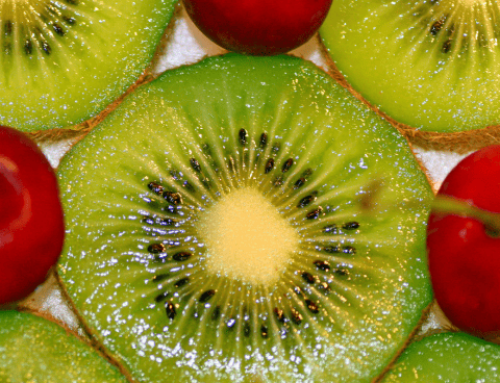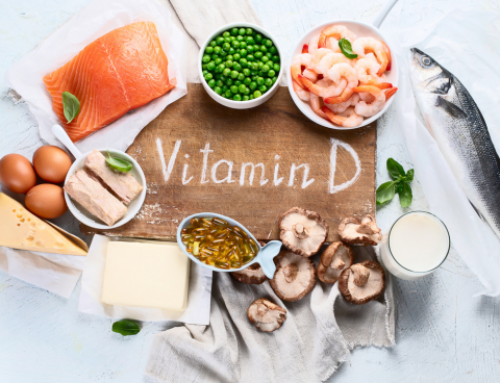Don’t Get Tricked by These 6 Foods With Wildly Unrealistic Serving Sizes
When you flip over the box to check a food’s nutrition facts, you expect that the figures you see will be correct. Government agencies such as the FDA make sure of that. But although the numbers for sugar, fat, vitamins, etc. are accurate, one number is often deceptive—the serving size. On many foods, the serving size presented is laughably small. Companies do this so that, at a glance, the nutrition info or their products looks better than it should.
Proposed updates to nutrition labels include more logical serving sizes, but even if they pass, you won’t see them on shelves for at least another couple of years. Until then, you deserve to know what foods are trying to trick you. Here are the six foods with insanely unrealistic serving sizes.
Trail Mix/Nuts
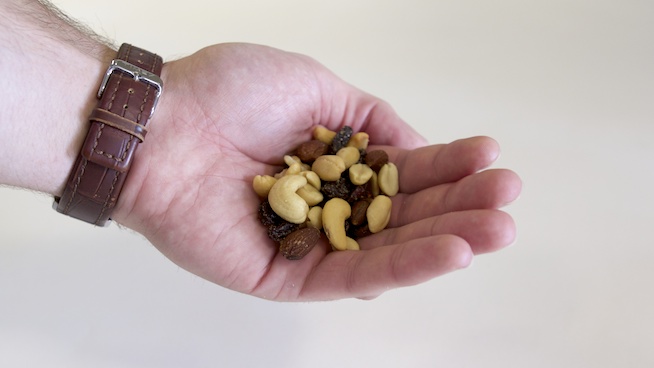
One serving of trail mix
Serving Size: 1 oz. 150 calories, 9 grams fat, 1.5 grams saturated fat, 7 grams sugar.
What You Actually Eat: 3 oz. 450 calories, 27 grams fat, 4.5 grams saturated fat, 21 grams of sugar.
Nuts are packed with protein and can be a fantastic source of energy. But odds are that you’re eating more than you think you are due to the paltry serving sizes. Dried fruit is the same way. One food that combines dried fruit and nuts, Trail Mix, sounds and looks like a healthy option. But its tiny serving size is deceiving with regard to overall nutrition. We grabbed a pack of “fruit and nut” trail mix that could easily be devoured in one sitting, only to find that the serving size is a mere 1 ounce and the package contained three total servings.
Those who don’t know better could easily pick up this packet of trail mix and consume the whole thing in one sitting, mistakenly assuming that they ate a reasonably healthy snack. This is not the trail mix packed with chocolate and candy. The nutrition facts above are for a trail mix with nothing more than peanuts, raisins, sunflower seed kernels, almonds, walnuts, cashews and cranberries. If you’re munching away on the “nut and chocolate” trail mix, the nutrition facts get even worse.
Learn how to build your own healthy trail mix.
Breakfast Cereal
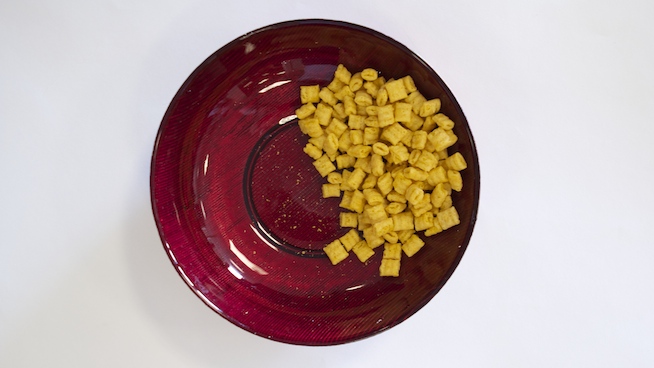
One serving of cereal
Serving Size: 3/4 cup, 120 calories, 3.5 grams fat, 1 gram saturated fat, 100mg sodium, 11 grams sugar.
What You Actually Eat: 2 cups, 320 calories, 9 grams fat, 2.7 grams saturated fat, 266mg sodium, 29 grams sugar.
Cereal has long been a traditional staple of people’s morning routines. They don’t think twice about its nutrition, and usually eat a big bowl every day. What they may not know is that most breakfast cereals have wildly inaccurate serving sizes. A recent study showed that the average American eats 30 percent more cereal than the standard serving size, and 10 percent of Americans eat more than 2-1/2 times the standard serving size. Colorful kids’ cereals are not the only ones with meager serving sizes. Many cereals perceived as “healthier” do the same darn thing.
If your bowl of cereal consists of 2 cups (which still doesn’t look like a whole lot), you could be starting your day with as much sugar as a can of soda, along with a good amount of fat and sodium. In a standard box of Cap’n Crunch, there’s supposedly 15 servings. Are you getting 15 bowls of cereal out of a single box? Probably not.
Learn how to pick out a healthy cereal.
Ice Cream
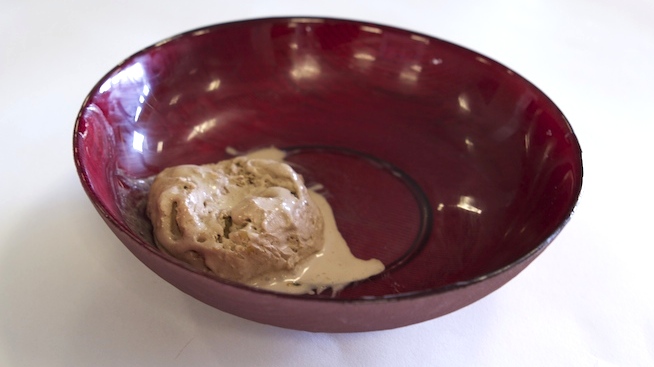
One serving of ice cream
Serving Size: 1/2 cup, 23 grams fat, 10 grams saturated fat, 75mg cholesterol, 85mg sodium, 22 grams sugar.
What You Actually Eat: 2 cups, 94 grams fat, 40 grams saturated fat, 300mg cholesterol, 40mg sodium, 88 grams sugar.
Ice cream obviously isn’t a healthy food, but the serving sizes camouflage just how bad it really is. If you glance at the nutrition for a pint of Haagen-Dazs Chocolate Peanut Butter ice cream, you won’t be happy with the numbers, but you might be able to rationalize them. That is, until you realize the serving size is only half a cup! That means if you eat the whole pint of ice cream (something we do more than we’d like to admit), you’re eating 4 total servings!
Translation: if you finish a pint of ice cream in one sitting, you’ve eaten 140 percent of your daily fat, 200 percent of your daily saturated fat, 100 percent of your daily cholesterol and a shocking 88 grams of sugar (which is equal to about 27 Chips Ahoy! cookies) in roughly 10 minutes. The standard serving size of most ice cream brands is so minuscule that it would melt before you even get the chance to finish it.
Ramen Noodles
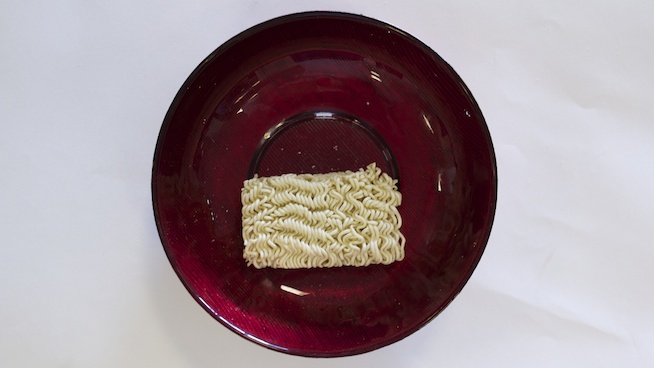
One serving of ramen noodles
Serving Size: 1/2 block, 190 calories, 7 grams of fat, 3.5 grams saturated fat, 830mg sodium, 26 grams carbohydrates.
What You Actually Eat: 1 block, 380 calories, 14 grams fat, 7 grams saturated fat, 1660mg sodium, 52 grams carbohydrates.
Ramen noodles are dirt cheap, easy to make and don’t taste terrible. That’s why they’re insanely popular. Too bad they’re such a dreadful nutritional choice. Besides containing some questionable chemicals, ramen’s nutrition is shockingly bad for such a simple food. If that isn’t enough to make you angry, wait until you hear their supposed serving size—half a block of noodles!
Yes, they expect you to open the plastic package, break off half the dried noodles and save the rest for later. Literally no one has ever done that in history (probably). There’s not a whole lot of food there to begin with, so you can’t blame people for assuming one package equals one serving. Ramen noodles are a classic case of a bad food tweaking its serving size to fool you into thinking it’s not completely awful for you.
Canned Soup
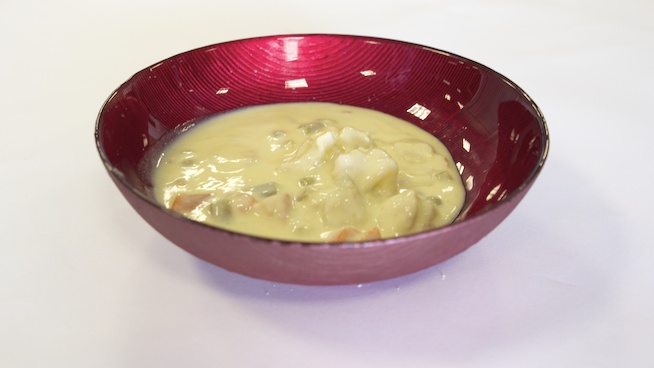
One serving of soup
Serving Size: 1 cup, 160 calories, 8 grams fat, 1.5 grams saturated fat, 30mg cholesterol, 890mg sodium.
What You Actually Eat: 2 cups (1 can), 320 calories,16 grams fat, 3 grams saturated fat, 60mg cholesterol, 1780mg sodium.
Soup is one of the biggest serving size offenders. At a glance, a can of Campbell’s Chunky Creamy Chicken and Dumplings soup looks moderately high in fat, saturated fat and sodium. Not good, but not too bad. Then you realize that one can of soup equals two servings. I’ve never made just half a can of soup. Not only is the serving size small, but the packaging doesn’t exactly lend itself to multiple uses.
If you’re going to search out the can opener, risk slicing yourself open on that sharp lid and try to figure out how to work the microwave, you’re going to want to heat up the whole can of soup. But when you look at the nutritional facts for a can of soup rather than a serving, the numbers are downright frightening.
Ketchup/Most Condiments

One serving of ketchup
Serving Size: 1 tbsp, 15 calories, 190mg of sodium, 4 grams of sugar.
What You Actually Eat: 3 tbsp, 45 calories, 570mg of sodium, 12 grams of sugar.
Condiment serving sizes are drastically underestimated, especially ketchup. Most people don’t realize how nutritionally poor ketchup is, in part because when they check out its nutrition facts, they don’t look too bad. That’s because they pertain only to a single tablespoon of ketchup. You know those tiny ketchup packets you see at cafeterias or concession stands? Yeah, those contain a full serving. For a condiment people douse on everything with little restraint, that’s way too small.
Sandwiches, burgers, hot dogs, meatloaf, fries, eggs, chicken and hash browns are almost always accompanied by ketchup, and normally much more than just a tablespoon. The same goes for condiments like ranch dressing (serving size of 2 tbsp.), BBQ sauce (serving size of 2 tsbps.) and mayonnaise (serving size of 1 tbsp.). Figuring out how much of that condiment you’re using can help you to avoid sabotaging what would otherwise be a healthy meal.
RECOMMENDED FOR YOU
Don’t Get Tricked by These 6 Foods With Wildly Unrealistic Serving Sizes
When you flip over the box to check a food’s nutrition facts, you expect that the figures you see will be correct. Government agencies such as the FDA make sure of that. But although the numbers for sugar, fat, vitamins, etc. are accurate, one number is often deceptive—the serving size. On many foods, the serving size presented is laughably small. Companies do this so that, at a glance, the nutrition info or their products looks better than it should.
Proposed updates to nutrition labels include more logical serving sizes, but even if they pass, you won’t see them on shelves for at least another couple of years. Until then, you deserve to know what foods are trying to trick you. Here are the six foods with insanely unrealistic serving sizes.
Trail Mix/Nuts

One serving of trail mix
Serving Size: 1 oz. 150 calories, 9 grams fat, 1.5 grams saturated fat, 7 grams sugar.
What You Actually Eat: 3 oz. 450 calories, 27 grams fat, 4.5 grams saturated fat, 21 grams of sugar.
Nuts are packed with protein and can be a fantastic source of energy. But odds are that you’re eating more than you think you are due to the paltry serving sizes. Dried fruit is the same way. One food that combines dried fruit and nuts, Trail Mix, sounds and looks like a healthy option. But its tiny serving size is deceiving with regard to overall nutrition. We grabbed a pack of “fruit and nut” trail mix that could easily be devoured in one sitting, only to find that the serving size is a mere 1 ounce and the package contained three total servings.
Those who don’t know better could easily pick up this packet of trail mix and consume the whole thing in one sitting, mistakenly assuming that they ate a reasonably healthy snack. This is not the trail mix packed with chocolate and candy. The nutrition facts above are for a trail mix with nothing more than peanuts, raisins, sunflower seed kernels, almonds, walnuts, cashews and cranberries. If you’re munching away on the “nut and chocolate” trail mix, the nutrition facts get even worse.
Learn how to build your own healthy trail mix.
Breakfast Cereal

One serving of cereal
Serving Size: 3/4 cup, 120 calories, 3.5 grams fat, 1 gram saturated fat, 100mg sodium, 11 grams sugar.
What You Actually Eat: 2 cups, 320 calories, 9 grams fat, 2.7 grams saturated fat, 266mg sodium, 29 grams sugar.
Cereal has long been a traditional staple of people’s morning routines. They don’t think twice about its nutrition, and usually eat a big bowl every day. What they may not know is that most breakfast cereals have wildly inaccurate serving sizes. A recent study showed that the average American eats 30 percent more cereal than the standard serving size, and 10 percent of Americans eat more than 2-1/2 times the standard serving size. Colorful kids’ cereals are not the only ones with meager serving sizes. Many cereals perceived as “healthier” do the same darn thing.
If your bowl of cereal consists of 2 cups (which still doesn’t look like a whole lot), you could be starting your day with as much sugar as a can of soda, along with a good amount of fat and sodium. In a standard box of Cap’n Crunch, there’s supposedly 15 servings. Are you getting 15 bowls of cereal out of a single box? Probably not.
Learn how to pick out a healthy cereal.
Ice Cream

One serving of ice cream
Serving Size: 1/2 cup, 23 grams fat, 10 grams saturated fat, 75mg cholesterol, 85mg sodium, 22 grams sugar.
What You Actually Eat: 2 cups, 94 grams fat, 40 grams saturated fat, 300mg cholesterol, 40mg sodium, 88 grams sugar.
Ice cream obviously isn’t a healthy food, but the serving sizes camouflage just how bad it really is. If you glance at the nutrition for a pint of Haagen-Dazs Chocolate Peanut Butter ice cream, you won’t be happy with the numbers, but you might be able to rationalize them. That is, until you realize the serving size is only half a cup! That means if you eat the whole pint of ice cream (something we do more than we’d like to admit), you’re eating 4 total servings!
Translation: if you finish a pint of ice cream in one sitting, you’ve eaten 140 percent of your daily fat, 200 percent of your daily saturated fat, 100 percent of your daily cholesterol and a shocking 88 grams of sugar (which is equal to about 27 Chips Ahoy! cookies) in roughly 10 minutes. The standard serving size of most ice cream brands is so minuscule that it would melt before you even get the chance to finish it.
Ramen Noodles

One serving of ramen noodles
Serving Size: 1/2 block, 190 calories, 7 grams of fat, 3.5 grams saturated fat, 830mg sodium, 26 grams carbohydrates.
What You Actually Eat: 1 block, 380 calories, 14 grams fat, 7 grams saturated fat, 1660mg sodium, 52 grams carbohydrates.
Ramen noodles are dirt cheap, easy to make and don’t taste terrible. That’s why they’re insanely popular. Too bad they’re such a dreadful nutritional choice. Besides containing some questionable chemicals, ramen’s nutrition is shockingly bad for such a simple food. If that isn’t enough to make you angry, wait until you hear their supposed serving size—half a block of noodles!
Yes, they expect you to open the plastic package, break off half the dried noodles and save the rest for later. Literally no one has ever done that in history (probably). There’s not a whole lot of food there to begin with, so you can’t blame people for assuming one package equals one serving. Ramen noodles are a classic case of a bad food tweaking its serving size to fool you into thinking it’s not completely awful for you.
Canned Soup

One serving of soup
Serving Size: 1 cup, 160 calories, 8 grams fat, 1.5 grams saturated fat, 30mg cholesterol, 890mg sodium.
What You Actually Eat: 2 cups (1 can), 320 calories,16 grams fat, 3 grams saturated fat, 60mg cholesterol, 1780mg sodium.
Soup is one of the biggest serving size offenders. At a glance, a can of Campbell’s Chunky Creamy Chicken and Dumplings soup looks moderately high in fat, saturated fat and sodium. Not good, but not too bad. Then you realize that one can of soup equals two servings. I’ve never made just half a can of soup. Not only is the serving size small, but the packaging doesn’t exactly lend itself to multiple uses.
If you’re going to search out the can opener, risk slicing yourself open on that sharp lid and try to figure out how to work the microwave, you’re going to want to heat up the whole can of soup. But when you look at the nutritional facts for a can of soup rather than a serving, the numbers are downright frightening.
Ketchup/Most Condiments

One serving of ketchup
Serving Size: 1 tbsp, 15 calories, 190mg of sodium, 4 grams of sugar.
What You Actually Eat: 3 tbsp, 45 calories, 570mg of sodium, 12 grams of sugar.
Condiment serving sizes are drastically underestimated, especially ketchup. Most people don’t realize how nutritionally poor ketchup is, in part because when they check out its nutrition facts, they don’t look too bad. That’s because they pertain only to a single tablespoon of ketchup. You know those tiny ketchup packets you see at cafeterias or concession stands? Yeah, those contain a full serving. For a condiment people douse on everything with little restraint, that’s way too small.
Sandwiches, burgers, hot dogs, meatloaf, fries, eggs, chicken and hash browns are almost always accompanied by ketchup, and normally much more than just a tablespoon. The same goes for condiments like ranch dressing (serving size of 2 tbsp.), BBQ sauce (serving size of 2 tsbps.) and mayonnaise (serving size of 1 tbsp.). Figuring out how much of that condiment you’re using can help you to avoid sabotaging what would otherwise be a healthy meal.


